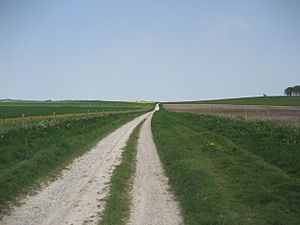Herepath facts for kids

A herepath (pronounced HERR-e-path) or herewag was a special kind of road in England. These roads were mainly used by armies and were built around the 800s AD. The name literally means "army path."
These paths were very important during a time of war. Southern England was often fighting against Vikings who came from Denmark. To protect his people, King Alfred of Wessex made many plans. He built strong, fortified towns called burhs, which were safe places for people to go. He also created herepaths to connect these burhs.
Sometimes, herepaths followed old routes that already existed. Other times, new roads were built just for this purpose. Because they were safer and often better maintained, ordinary people and traders also used herepaths a lot. They were like the main highways of their time!
What Does "Herepath" Mean?
The word "herepath" comes from the Old English language. In Old English, the word here meant "armed host" or "army." You can find this word in other old terms too. For example, a "harbour" was originally a "burh" (a fortified place) with an army stationed there. A "heretoga" was a leader of a militia or army.
Herepaths in Other Languages
Other languages that are related to English also have similar words. For example, in German, there's Heerweg, and in Danish, there's Hærvejen. These words also mean "army road." Over time, in all these languages, the term "herepath" or its similar words just came to mean any public road. These were roads that the government paid to keep in good condition.
Herepaths Today
Many herepaths still exist today, though they might not be called "herepaths" anymore. Sometimes, local stories say these old roads have magical or mysterious beginnings. This is especially true in the Wessex region of England, where King Alfred ruled. Often, any old track or path in that area might be called a herepath, even if it wasn't originally a military road.

